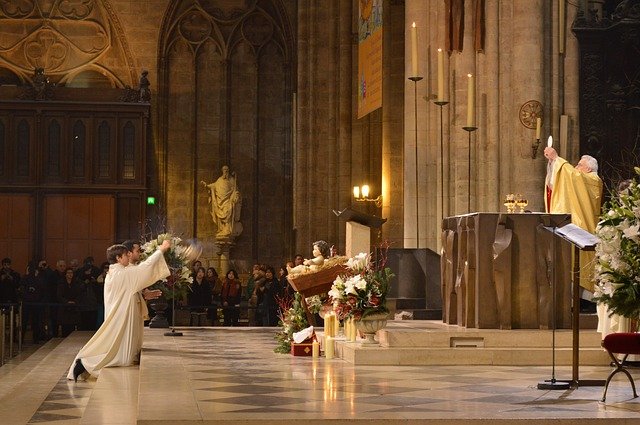Perhaps the most well-known scripture in Christianity is John 3:16:
For God so loved the world, that he gave his only begotten Son, that whosoever believeth in him should not perish, but have everlasting life.
This powerful statement of loving divine intention is the best possible starting point for forming a Christian worldview. However, this verse does not stand alone; in subsequent verses, Christ offers Nicodemus additional insight into His purpose and why the world responds to Him in the way they do:
For God sent not his Son into the world to condemn the world; but that the world through him might be saved. He that believeth on him is not condemned: but he that believeth not is condemned already, because he hath not believed in the name of the only begotten Son of God. And this is the condemnation, that light is come into the world, and men loved darkness rather than light, because their deeds were evil. For every one that doeth evil hateth the light, neither cometh to the light, lest his deeds should be reproved. But he that doeth truth cometh to the light, that his deeds may be made manifest, that they are wrought in God.
These references to light and darkness might bring to mind shades of color, but the Greek root used here for light (phos) is not a reference to color, but illumination. Similarly, the Greek root used here for darkness (skotos) is also not a reference to color but rather the absence of illumination. In this passage, Christ describes humanity’s preference not to see reality with God’s clarity because God’s clarity illuminates the true nature of the things we love and forces us to face truth that we would prefer to avoid.
The Greek root phos is also the root for the word photismos, which we translate in English as enlightenment. Ideally, our use of the word enlightenment would connote increased perception of reality, but as is true of so many things, it has taken on self-serving meanings in Western culture.
In his famous book Stages of Faith, psychologist James Fowler puts forward a model to illustrate the development of faith and how this process corresponds to our human development. In the early stages of Fowler’s model, we as children form our impressions of God in the same way we make sense of the world around us—primarily through stories that offer explanations for our observations and experiences. As we grow into adolescence and adulthood, we move into new stages where the simple stories of childhood no longer serve our growing awareness of questions of justice, fairness, and reciprocity. So, we take responsibility for the formation and maintenance of our belief system. In later stages, we grow in our capacity to live with ambiguity and paradox, and we relativize in light of our increased exposure to different points of view. The greatest understanding of God is granted not to the sophisticated but to the childlike.
There is much to be praised in Fowler’s attempt to document and describe stages of faith. Our faith often does move through stages as our lives progress and our perceptions of the world change. But Fowler’s model operates with two fatal flaws: first, Fowler sees his stages of faith as progressions toward more ideal forms of faith, characterized by increasing sophistication. The Christian model expounded by Jesus and later Paul is different. Paul taught that the greatest understanding of God is granted not to the sophisticated but to the childlike and those whom the world considers intellectually simple or weak. In Christian epistemology, sophistication is more often than not a detriment to our ability to perceive God’s reality.
The second fatal flaw is his final stage six, which portrays social activism as the highest and most desirable manifestation of enlightenment. This notion of enlightenment is self-serving for the non-believing, as evidenced by Fowler’s acknowledgment that “… whenever I try to speak on the stages of faith and try to describe the structural features and style of each stage, it is always stage six that people are most interested in. The more ‘secular’ the audience, the greater the interest.” Fowler speculates that the reason for the secular-minded obsession with stage six is that the figures he cites as emblematic of this stage (MLK, Bonhoeffer, Merton, and others) are compelling; in his words, these activist figures “embody the promise and lure of our shared futurity.”
This observation is inaccurate, I believe. In my own careful reading of this all, I would argue the reason for a fixation on Fowler’s stage six among the secular-minded has little to do with those famous personalities. Instead, the stage six pivot to an activist orientation offers freedom from the psychic burden of believing in specific things, such as miracles and revelation, that are foreign to many people’s personal experiences. The secular-minded do not gravitate to Fowler’s stage six alone out of an interest in a better world; at least in part, their fixation on stage six seems to be motivated by avoidance of other difficult questions and a craving for psychic relief.
This mistaking of relief for enlightenment is not unique to Fowler; it is a common mistake in the West where faith is viewed as in most other aspects of life, in terms of self-fulfillment. And Fowler is not entirely wrong about the importance of activism: God’s plan for humanity does involve a divine concept of social justice, to be sure, but it also consists of a system of roles, laws, responsibilities, and gifts, all of which operate in ways that contradict our hyper-individualistic Western notions of reason and fairness. We know from the prophetic tradition and the Savior’s life that wrestling with all of these aspects of God’s plan is not a sign that we are at lower stages of faith. Instead, this wrestle is part of the very life that God lives, a constant balancing of essential commitments to love, order, justice, mercy, and other values that so often seem to exist in tension.
In this and other areas, the life of Jesus reveals to us the heart of God. Despite self-serving attempts from scholars and commentators to fashion a Jesus who is palatable to one ideological tribe versus others, Jesus, the advocate for the poor, is also Jesus who calls the temple His father’s house and celebrates a poor widow’s contribution to the temple establishment. And lest we imagine God to be a relativist, Jesus, whose inclusive ideas of redemption lead him on a mission among Samaritans, is also Jesus who pronounces ominous judgments upon entire cities for their rejection of the apostles.
The same Jesus who weeps with Mary and Martha over Lazarus gives a terse reprimand to a frightened and confused John the Baptist in his prison cell: “blessed is the one who is not offended by me.” The same Jesus who says “Come unto me …” and forges a community of believers, also says, “Do you think that I came to bring peace to the earth? No, I say to you, but rather division.”
Again, contrary to what we might infer from Fowler’s model, Jesus shows us that enlightened behavior is both inclusive and exclusive; both blessing and condemning; both empathetic and dismissive. In revealing to us the heart of God, Jesus shows that contrary to what many in Western new age and contemplative movements might have us believe, God does not float above these tensions on a transcendent cloud of psychobabble.
Rather, enlightenment—culminating in the Eternal Life that Jesus offers us—consists of an ever-increasing capacity to embrace reality, including realities that both unite and divide; that cause us to rejoice on the one hand and grieve on the other.
As with so many areas of life, we learn what enlightenment is both by experiencing it and observing its opposite. For example, our modern tendency toward strict partisan division in politics, media consumption, and other areas of life can be understood as nothing more than a manifestation of our preference for subsets of reality that validate us (a preference no doubt emboldened in an atmosphere where we grant no other authority the power to question our hearts and minds). Faith once enlightened Western societies by pointing us to realities of transcendence and trust, thereby building a connection to God and strong communities. Now, as many have abandoned faith, conspiracy theories on the right and critical theory on the left have filled the void, giving their adherents a sense of certitude that many mistake for enlightenment.
In light of this, as we approach Easter, we are offered another opportunity to consider what we believe and why. John 3 teaches us that inseparable from what we believe is the question of what we love. Easter orients the believer first to the reality of the cross, which Paul characterizes as a story of weakness that upends the world’s notions of strength. In Christianity, we find a member of God’s innermost circle born in a conquered vassal state, rejecting any form of political power, and submitting to an agonizing and humiliating death in solidarity with the “least” of humanity. In contrast with the deities of ancient cultures who take the form of powerful elements like thunder and water and dominant animals like bulls, crocodiles, and hawks, Christ is the lamb. Rather than offer a faith that makes God understandable and predictable, Christianity provides a radical view of the Son of God crying out in confusion and despair, My God, My God, Why hast thou forsaken me? Part of the message of the cross is that reality is painfully counterintuitive; the idea that the Son of God would suffer and die crucified between thieves, as Isaiah said, “numbered among the transgressors,” is inconceivable in the ways that the world envisions influence and power.
If the realities of the cross strain our paradigms, we find no relief as we next contemplate the resurrection. We know from the accounts in the Gospels that the first witness of the resurrection was a woman, which NT Wright demonstrates to be a severe violation of cultural expectations that adds credibility to the gospel accounts. “The point has been repeated over and over in scholarship, but its full impact has not always been felt: women were simply not acceptable as legal witnesses. We may regret it, but this is how the Jewish world (and most others) worked.” The resurrected Lord’s physical appearances to women, then walking and breaking bread with disciples on the road to Emmaus, then eating with his disciples, defy attempts to understand the resurrection as “metaphorical,” or merely “visionary.” As Jesus expressed in John’s gospel account, we love our inability to see clearly, and we will go to great lengths to avoid seeing realities that we don’t love. The ability of commentators to formulate creative alternative explanations for the resurrection is not confirmation the resurrection is ahistorical; it rather points towards the extent to which human beings can marshal immense creativity and sophistication in their denial of concrete reality.
As Western societies increasingly turn from the reality of Christ toward unreality in the form of secular religions, Christianity can shine ever more brightly by contrast. And as failing Christian denominations abandon the reality of Christ’s atonement and resurrection in a misguided pursuit of ideological inclusivity, those of us who remain committed to these realities have an opportunity to show the world what it means to love clarity:

As New Age movements seek to reconceptualize the Christ as a manifestation of a “divine essence” that is also somehow everything around us, we can affirm the testimony of witnesses, that the resurrected Christ is not an “essence” but a wounded individual who bore immense harm, who has chosen healing over grievance identity, and who desires to be personally known.

Finally, NT Wright envisions the opportunity that Easter affords us to embrace enlightenment over its counterfeits:
Christian holiness is not (as people often imagine) a matter of denying something good. It is about growing up and grasping something even better. Made for spirituality, we wallow in introspection. Made for joy, we settle for pleasure. Made for justice, we clamor for vengeance. Made for relationship, we insist on our own way. Made for beauty, we are satisfied with sentiment.
But new creation has already begun. The sun has begun to rise. Christians are called to leave behind, in the tomb of Jesus Christ, all that belongs to the brokenness and incompleteness of the present world. It is time, in the power of the Spirit, to take up our proper role, our fully human role, as agents, heralds, and stewards of the new day that is dawning. That, quite simply, is what it means to be Christian: to follow Jesus Christ into the new world, God’s new world, which he has thrown open before us.
May we receive that “new world” with everything we’ve got—and appreciate this weekend the One who makes a new day possible for us all.
















